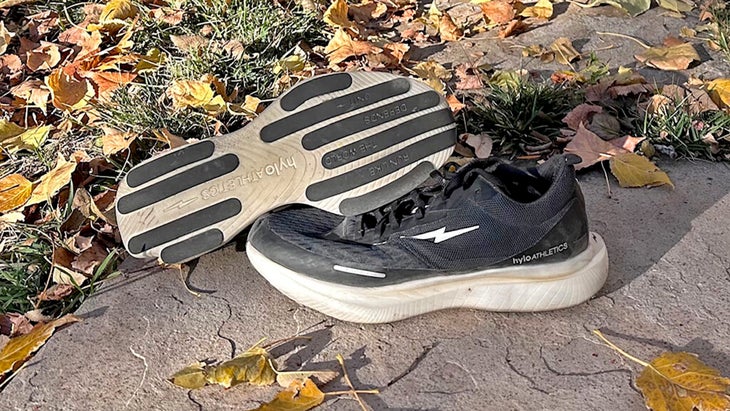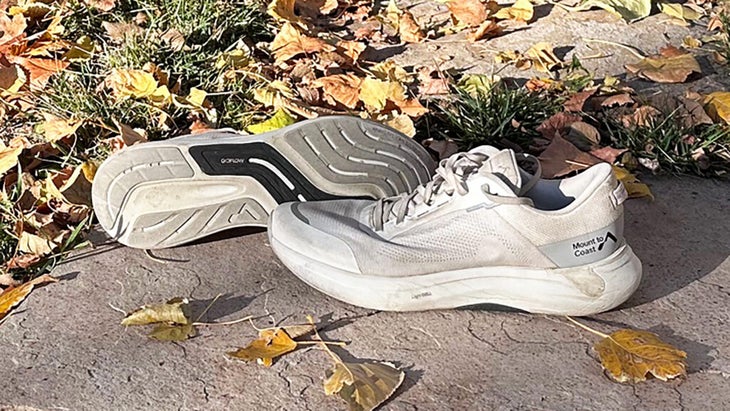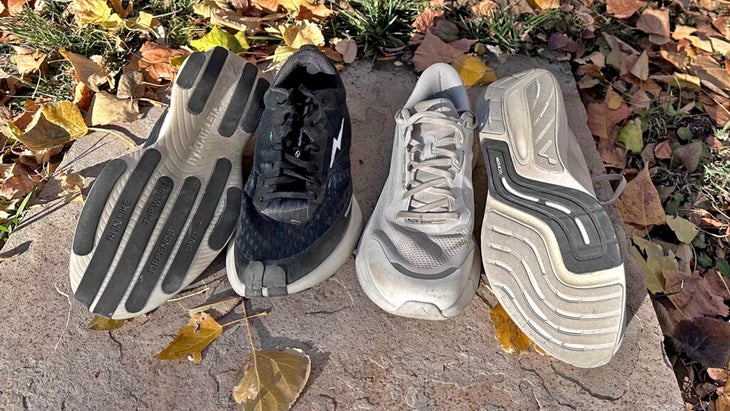New perk: Easily find new routes and hidden gems, upcoming running events, and more near you. Your weekly Local Running Newsletter has everything you need to lace up! Subscribe today.
It was an unplanned meeting. Vincent Zhang, freshly arrived from his flight from China, sat near the sidewalk across from my office building in Boulder, Colorado. As I walked past Zhang, my eye caught the pair of distinctive bright white Mount to Coast R1 running shoes he was sporting. Outside of the running industry trade show in Austin, Texas, I had yet to see someone wearing a pair in the wild so I did a double-take and asked him about his shoes, only to learn he was the head of supply chain for Mount to Coast, an emerging shoe manufacturer in Hong Kong and Southern China.
The shoes I was wearing, HyloAthletics new Impact model, were also rarities. Zhang had, however, just picked up a pair in London, where that company is based, so he knew about the brand, also a newcomer in the U.S. Both brands have pushed hard to create the ultimate “green” running shoes, but they’ve taken different approaches toward making more sustainable products.
I have been wear-testing both the HyloAthletics Impact and Mount to Coast’s S1 training shoe for several months, racking up a few hundred miles on each. And the comparison and contrast of the shoes have had me asking some hard questions.

Hylo Athletics Impact
Weight: 8.5 ounces (women’s size 8), 9.9 ounces (men’s size 9)
Stack Heights: 33mm (heel); 25mm (forefoot)
Drop: 8mm
The Impact is so eco-friendly you could eat much of the bio-based shoe. Not that it would taste good, but at least it wouldn’t be lethal.
Between the castor bean-based PEBA super foam midsole, natural rubber outsole, corn-derived lining, and laces derived from wood pulp, these shoes, like the “green” shoes from Allbirds and Veja, are manufactured with the objective of having a light touch on our planet.
Hylo’s product director and co-founder, Jorma Seabourne says that Hylo’s reason for using bio-based materials is that by doing so and recycling the shoes, they can eventually be free from fossil fuel-based materials.
Seabourne explains that one of the key materials in the HyloAthletics Impact is a bio-polymer called PA11, which he says outperforms standard forms of nylon and is more sustainably based. He notes that it is by far the best bio-polymer available, but one that comes at a “very high cost.”
For the first 125 miles or so of my testing, the bio-PEBA provided the cushioned ride and firm midsole feeling of fossil-based PEBA shoes found in many of today’s high-end super racers and trainers. But, after logging more than 200 miles on the Impact, the midsole began to lose firmness, like a tire with a slow air pressure leak. In other words, the shoes began to feel flat.
The cushioning was there but the responsiveness gradually dissipated as I continued to use the shoes. Now, at over 200 miles, I have more ground feel underneath my feet than I’d prefer. As eco-redemption, I can avail myself of Hylo’s Hyloop platform that allows consumers to return the brand’s used shoes for inclusion in a recycling program that puts the materials back into Hylo’s input stream once 2,000 pair have been collected. This further decreases the brand’s already-gentle footprint on Earth.
The Impact’s initial performance was impressive, with the resilience of its bio foam being better than other green midsole compounds I’ve tested the last several years. But, I was dissapointed that the shoe felt flat after so few miles. The outsole and uppers didn’t show much in the way of wear, although the lining had minimal ripping on the heel.
Seabourne says he has seen the Impact last for as few as 400 miles and upwards of 1200 miles.
“The runner has their part to play in the way they care for their shoes, and also how they run, in terms of gait, where they consistently bear weight,” Seabourne said, “and if the shoes were the correct shoes for them in the first place.”
One could argue that, because the Impact is recyclable and has an environmental score at least twice as good as most competitors’ products made with eco-damaging ingredients, its longevity could be half as long and the shoe would still come out ahead on the eco-scale.
Or one could contend that longevity is more important.

Mount to Coast S1
Weight: 8.3 oz (women’s size 8), 9.3 oz (men’s size 9)
Stack Heights: 36mm (heel), 26mm (forefoot)
Drop: 10mm
Mount to Coast’s S1 came across as a successful chemistry experiment, the objective of which was to make a shoe that won’t fatigue or degrade through use. After putting more than 200 miles on the S1, the only wear I can recognize is the discoloration of the white upper (which, apparently, occurs because the recycled material undergoes a “redox” reaction—an oxygen-reduction like a banana’s spotting and browning—because Mount to Coast does not spray chemicals on the surface to prevent it from occurring, as do other brands). Mount to Coast made this choice as an environmental decision, consistent with S1’s upper being made of 100 percent recycled yarn.
The S1’s midsole durability stems from a combination of midsole chemistry—some from race car shock absorber advancements—that manifests in an almost indestructible nitrogen-infused foam.
Mount to Coast’s supercritical foaming (gas-infusion) process sources its nitrogen from the atmosphere, converting it into a supercritical fluid type (between liquid and gas state) for the foaming process and releasing it back, rather than purchasing liquid nitrogen as an ingredient from a third party.
This process is not only for ecological purposes, but also allows for purer nitrogen and higher pressure during the saturation process, resulting in a more stable, durable midsole foam. Into that midsole base Mount to Coast places a forefoot “ZeroSag” insert. The synthetic ZeroSag material was co-developed with BASF for its consistent cushioning elements, as demonstrated in the suspension systems of race cars.
Mount to Coast’s R&D and manufacturing operation in the Pearl River Bay area in the Hong Kong region works with a LEED Gold-certified production facility in which 15 percent of the electricity is solar generated.
While Mount to Coast’s eco bona fides matter to consumers, the fact that its shoes perform without degradation over so many runs is perhaps the biggest green attribute, particularly given that few runners will compromise performance for sustainability.
In fact, after Mount to Coast spoke with more than 500 runners all over the world in an effort to gather consumer insights—including many North American specialty running retailers—one of the biggest takeaways, especially to longer-distance runners, was that the first priority was performance. According to Zhang, the consumers reported they “would never choose a sustainable shoe if it compromised performance in any way.”
That being said, their findings show that runners are happy with a multitude of sustainable approaches (recycle/bio-polymer/bio-degradable/low carbon emission, etc.) so long as the shoe itself is high performing. Mount to Coast was told repeatedly that a pair of shoes that lasts twice as long and created with at least some recycled materials would be considered sustainable.
As a result of these findings, Mount to Coast is working with BASF to develop a shoe that balances performance with sustainability even more effectively, without compromising its mission of creating high-mileage, durable shoes. And, within the next year, it hopes to release a durable performance shoe made through a 100 percent circularity model, minimizing carbon emissions and using no new materials derived from petrol.
RELATED: Spray-on Shoes Are Real. Watch How On’s Cloudboom Strike LS Super Shoes are Made

Is All-Natural Always the Healthiest Choice?
Looking at the two companies’ strategies one wonders, is it better for a shoe to be made of plant-based eco-friendly materials or for a shoe to last longer, thereby reducing waste?
HyloAthletics and Mount to Coast are striving to achieve both these sustainability and performance benefits, from different points in the spectrum.
Which approach is better may come down to optics and consumer behavior. Wearers of green shoes find value in an Earth-friendly appearance, thus are more likely to buy a sustainable model. Brands like HyloAthletics, Veja, Allbirds, On Running, and NNormal look green, and are true to their word when they proclaim environmental benefits.
But one must ask, how long do these shoes perform at a top level? Are less-durable materials that look (and even are) more sustainable a form of fashionable green-washing?
Then again, do runners actually completely wear down their shoes—the upper, midsole or outsole—to the point of failure? It’s hard to discount the reality that many runners enjoy shopping and acquiring new gear on a regular basis.
I asked Tina Muir, a sustainability consultant and co-author of Becoming a Sustainable Runner: A Guide to Running for Life, Community, and Planet, where she lands on the hypothetical situation. How does she rate the environmental impact of a shoe made from plant-based materials but that performs for only one-third the distance of one manufactured with fossil fuel-based components.
Muir says she endeavors to push the running industry “to keep innovating with new materials to make the overall environmental impact of our shoes lower.” But she does not want that to be at the expense of durability and quality. “If they trade out natural materials for some of the synthetic materials, but the shoes only last 100 miles, it is continuing the consumerism cycle that we must break and therefore limiting the ability of Mother Earth to heal and regenerate,” she says. In sum: both matter.
